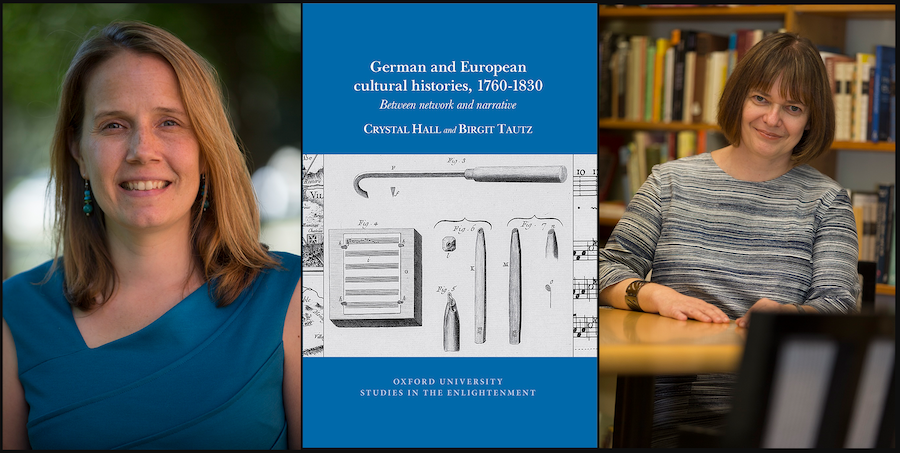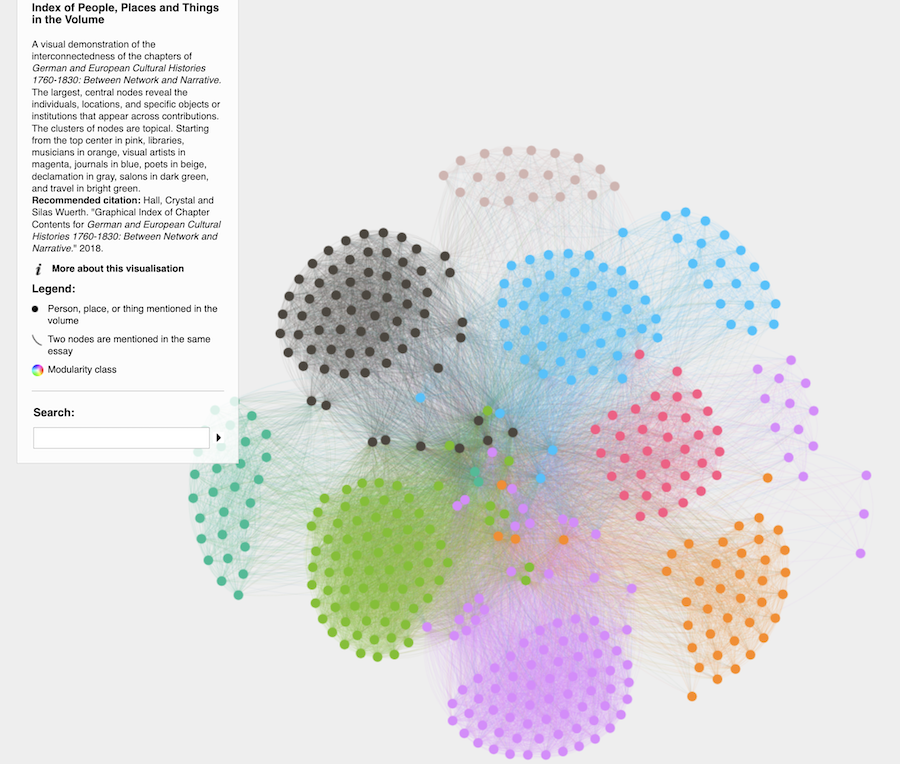New Pathways Through European History
By Rebecca GoldfineAt the start of their recent book talk at Bowdoin, professors Birgit Tautz and Crystal Hall instructed their audience on what to do with their phones. But they didn't issue the usual warning to keep the gadgets silenced and out of the way.

Instead, they asked people to take them out and scan the QR code printed on bookmarks that were being passed around. The code opened the online counterpart of their new edited volume, German and European Cultural Histories, 1760-1830: Between Network and Narrative, with interactive images, maps, text, and data visualizations.
“To follow along, you'll deviate, you'll click to the next illustration or another collection, you'll pursue alternate pathways to the ones that we're telling you to follow,” Tautz said. “You just go wherever you want to go.”
Tautz and Hall teach in different departments—German and Digital and Computational Studies, respectively—but their research interests in European cultural history overlap (though Tautz focuses her scholarship on the eighteenth century and Germany, mainly, while Hall is more specialized in the Italian Renaissance). Their new volume, which is part of the Oxford University Studies in the Enlightenment series, was published by Liverpool University Press.
Old and New Networks
The book emerged from one of their early collaborations, a 2017 symposium at Bowdoin that brought together twenty-two scholars in their fields. The symposium, called Network@1800, focused on the power of digital humanities to open new areas of inquiry into a period of European history, around 1800, when modern forces swept through politics, economics, arts, and literature.
The symposium, as its name implies, focused on connections across German lands, Europe, and the Atlantic, and the myriad networks—from salons and libraries to trans-Atlantic journals—that influenced the changes happening at the time. Some of the academics who attended the symposium ended up contrubuting essays to the new volume.
Twelve writers contributed to German and European Cultural Histories, including Hall and Tautz, who also created the companion website. The book, and for that matter, the symposium that inspired it, is unusual in that it combines digital humanities scholarship with more traditional methods of research and analysis.
“That is incredibly rare in the field of digital humanities, and in the fields of Italian and German studies," Hall said, adding that the book also includes perspectives on British and Francophone cultures. “It isn't often that you have a volume that brings those approaches into conversation with one another.”
Tautz expanded on this point: "From our vantage point in the US, we tend to look at European cultural histories in terms of the Anglophone world, as nations (even if they did not actually exist as a unified political entity, as in the case of eighteenth-century Germany), or as the big event—the French Revolution and its impact—or the origins of colonialism," she said. "Our book, despite focusing on what we have come to associate with nations, turns to our ways of thinking community, collaboration, center, and periphery. And we combine methods from different national traditions and approaches to scholarship."
The book's eleven chapters cover an array of topics—salons, traveling declamators, the circulation of prints, the publishing of books, art collectors, James Bowdoin III's library, letter-writing, travel narratives, the expression kosmopolit (cosmopolitan), and Beethoven's conversation notebooks. The essays are arranged into three themes that “reflect exchanges around 1800:” social capital, material cultures, and reading.

The subtitle of their book, Between Network and Narrative, plays with the double meaning of network, signaling its reference to the configurations of people, institutions, and places connected by ideas, places, books, travel, or other means—as well as to its use as a digital analysis tool, “the dominant digital humanities method featured in the book.”
Hall said that studying history via networks can reveal both a more complete account as well as overlooked elements. “We so often tell stories of this period in a grand narrative,” she said, one that marches along in a straightforward fashion. “When we put things into a network mode we look at the pieces simultaneously, we explore the edges, we think about how or if people can enter into the narrative, and we expand what it means to be part of the narrative.”
Different Ways of Reading
The book's digital platform, which is free to use, allows readers to create their own pathways and connections through the material. “The volume tells many parallel stories at the same time,” Tautz said. “It forces different ways of reading."
She continued: “We tend to read in a linear way, or we tend to read for closure, or we tend to read for the big narrative, or from beginning to end. And I think by having both methods side by side [digital and hard copy], it allows for different modes of reading.”
After clicking open the Between Narrative and Network website, which doesn't include the full manuscript of the book, readers are met with choices, like text they can scroll that have been seasoned with links to related content. Or they can dive directly into the book's "resources," such as its collections of maps and scans of old writings.
“By following these visual cues, there are different ways into the story," Tautz said. "You could go through the prints and paintings or the data visualizations, you can click through all the images, and you get a completely different story.”
The digital platform for the book, an application by Manifold, could also draw more engagement. “Our fields are so small, and there are few readers, but I think statistically, more people may read the book if they enter through the digital platform than if people were to read just a book,” Tautz conjectured.
Below is a sampling from the book's visual assets. These prints accompany Joachim Homann's chapter, “‘Luftschiff der Phantasie’: Johann Christian Reinhart, Friedrich Schiller, Artistic Networks around 1800,” and Sean Franzel's chapter, “Periodicals, Reading Rooms, Paper Shops: Taking Inventory of the 'Age of Paper.'”




An Open Book
Both authors said the accessibility of their new book is one of its most important attributes. Readers, if they log in, can not only click through its media exhibitions and interactive visualizations, they can also annotate the text, making their notes public or private.
“This is a project that invites dialogue and is eager to be revised in dialogue. It is just one note of a larger network of scholarly conversation,” Tautz said.
The annotation feature rebuts the idea that a book provides the final word on an argument—at least until another publication comes along challenging it. “There is a transparency of scholarly discussion,” Hall said. “Readers can annotate, there can be conversation, you can have an entire peer-review space where scholars and laypeople make notes, and it becomes a much more communal process as opposed to something that is very...”
“Rigid and occluded,” Tautz finished Halls's sentence. As in, she added, “When the book is done, it is done, and shelved." Instead, "we position our book as a project that invites dialogue and is eager to be revised as just one note of a larger network of scholarly conversation."
Below is a static screenshot of the volume's more fluid and interactive networked index, or what Hall and Tautz describe as “a visual demonstration of the interconnectedness of the chapters.”

Each dot in the network above represents a person, place, or thing mentioned in the book. Pink, for instance, stands for libraries; musicians are orange; visual artists are magenta; journals are blue; poets are beige, etc. "Instead of seeing clusters that represent chapters, you see nine communities which show the book has significant overlap across the chapters," Hall said. "For example, Italy is mentioned with a lot of different places and individuals and across several chapters, in different contexts. We don't have a section in the book called 'Italy,' but this would be a way to think about what is it we can understand about Italy from these clusters."
Banner illustration: For di Augusto, Giovanni Battista Piranesi. 1748, etching on laid paper, 5 1/4 x 10 9/16 in. (plate), National Gallery of Art, Washington, DC, Edward E. MacCrone Fund and the Eugene L. and Marie-Louise Garbáty Fund, 2002.66.1.15. (Open access)
Networked Index: Hall, Crystal and Wuerth, Silas. "Graphical Index of Chapter Contents for German and European Cultural Histories 1760-1830: Between Network and Narrative." 2018.